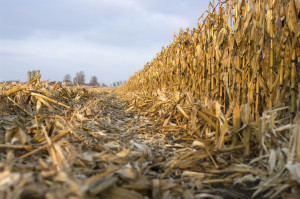 Corn stover, also called stubble, is what remains on a cornfield after harvest (usually a combination of left behind stalks, leaves, and cobs.) This biomass, a broad term meaning any source of organic carbon that is renewed rapidly as part of the carbon cycle, can be used in producing ethanol.
Corn stover, also called stubble, is what remains on a cornfield after harvest (usually a combination of left behind stalks, leaves, and cobs.) This biomass, a broad term meaning any source of organic carbon that is renewed rapidly as part of the carbon cycle, can be used in producing ethanol.
According to a new study by Purdue University published by the Canadian Center of Science and Education, researchers have found that making biofuel from corn stover could become economically viable for farmers with government support.
Corn stover is considered a “second-generation” biofuel feedstock. Second generation biofuels, sometimes called “advanced biofuels,” are distinguished from “first-generation” biofuels by the fact that feedstock used in producing second-generation biofuels are generally not food crops and therefore do not threaten food chains.
As lead author Farzad Taheripour, a research associate professor, explained for the study,
“The development of second-generation biofuels is critically important to advancing the biofuels industry. First-generation biofuels, produced from food crops, will not be able to replace a large portion of the oil-based liquid fuels because a rapid expansion in these biofuels could have adverse impacts on our food supply.”
From the study, the researchers concluded that the supply of stover-based biofuel will be very limited with such low levels of crude oil prices, especially if the government is not supporting bio-gasoline production. But, with a bio-gasoline subsidy of just $1.01 per gallon, the market could produce significant amounts of bio-gasoline, especially at medium and higher crude prices.
Researchers projected that with a viable corn stover market and stover at a farm price of $85.40 a ton, a large majority of farmers would find it profitable to harvest stover and therefore incorporate it into their business.
The agricultural economists at Purdue then decided to examine how this kind of subsidy would affect corn and soybean markets as well as the traditional corn-soybean crop rotation in the United States.
Corn-soybean crop rotation is a common practice in the US, as farmers have found that including soybean in corn crop rotation increases corn yields while significantly lowering pest management costs. If farmers began to consider revenue from both stover and corn in making planting decisions, and the joint profits from corn and corn stover were higher than from soybean production, it’s likely that farmers would grow more corn, more continuously versus the traditional corn-and-soybean rotation.
“If second-generation biofuels became economically viable and a massive amount of biofuels were produced from agricultural residue, this could have a major impact on the agricultural commodity markets,” said energy policy specialist Wallace Tyner, Professor of Agricultural Economics and a co-author of the report.
With increased economic viability, it was found that corn production and profitability would be more greatly affected compared with other crops. It was postulated that crop rotation practices in the Midwest would favor continuous corn growth, and that corn and soybean production would expand to areas other than the historic Corn Belt.
All of this of course depends on getting the proper government backing that would make this biomass a profitably and viable source of income for farmers. It will be interesting to see how this and other recent findings on the importance of government involvement will affect that renewable energy sector in the coming months.
